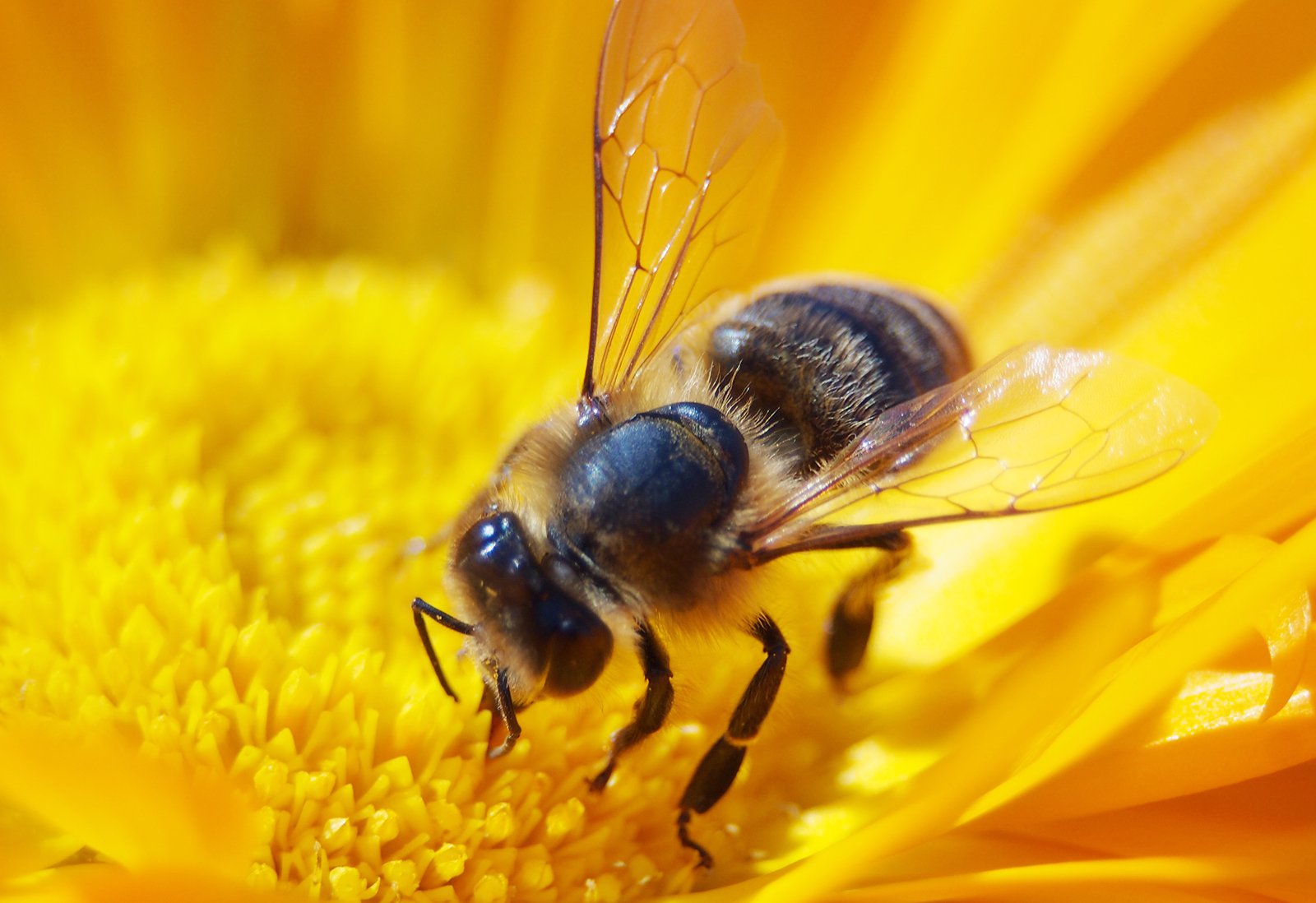

Honey
Honey is a sweet syrupy substance produced by honeybees from the nectar of flowers and used by humans as a sweetener and a spread. Honey is comprised of 17-20% water, 76-80% glucose, and fructose, pollen, wax, and mineral salts. Its composition and color is dependent upon the type of flower that supplies the nectar. For example, alfalfa and clover produce a white honey, heather a reddish-brown, lavender an amber hue, and acacia and sainfoin a straw color.
Background
Honey, golden and sweet, has always been held in high regard. The Bible refers to heaven as the “Land of Milk and Honey.” In ancient times, honey was considered the food of the gods and the symbol of wealth and happiness. It was used as a form of sustenance and offered in sacrifice. In the Middle Ages, honey was the basis for the production of mead, an alcoholic beverage. Because of its antiseptic qualities, physicians found it a perfect covering for wounds before the advent of bandages. Even Napoleon was enchanted by it, choosing the honeybee for his personal crest.
Beekeeping is one of oldest forms of animal husbandry. Early beekeepers encouraged the establishment of bee colonies in cylinders of bark, reed, straw, and mud. However, when the honeycomb was removed from the cylinders, the colony was destroyed.
Honeybees were brought to North America in the mid-1600s. Although there were bees on the continent, they were not honeybees. Early settlers took note of the bees’ penchant for hollow logs. They developed a “bee gum,” by placing sticks crosswise over the opening of the logs to support the honeycombs. This not only allowed for the comb to be removed from one end, but also kept the comb intact so that the colony could use it again.
In Europe, beekeepers working toward a similar goal, developed a device called a skep. It was essentially a basket placed upside-down over the beehive. The full honeycombs were removed from underneath. A further innovation called for cutting a hole in the top of the hive and placing a straw or wooden box over the hole. The box would eventually fill with honey as well. It could then be removed without harming the comb.
In the mid-nineteenth century, an American named Moses Quimby improved upon the beekeeping system by layering a number of boxes over the main chamber. But it was the Reverend Langstroth who was responsible for creating the basis for the method that is currently used. Langstroth’s moveable frame hive allowed for easy extraction and reinsertion of the combs. It consisted of a base, a hive body fitted with frames that contained the brood chamber, one or more removable sections (called supers) that were also fitted with frames for honey storage. The entire system is protected with waterproof covers.
Another popular type of hive is the leaf hive. This is a wooden box divided by means of a metal grid into an upper (honey) chamber and a lower (brood) chamber. Just above the floor and above the grid are racks of horizontal metal bars. Frames that hold the hanging honeycombs slide onto the racks.
Raw Materials
An average bee colony produces 60-100 lb (27.2-45.4 kg) of honey each year. Colonies are divided by a three-tier organization of labor: 50,000-70,000 workers, one queen, and 2,000 drones. Worker bees only live for three to six weeks, each one collecting about one teaspoon of nectar. One pound (0.454 kg)of honey requires 4 lb (1.8 kg) of nectar, which requires two million flowers to collect.
When the worker bees are about 20 days old, they leave the hive to collect nectar, the sweet secretion produced by the glands of flowers. The bee penetrates the flower’s petals and sucks the nectar out with its tongue and deposits the nectar into its honey sac or abdomen. As the nectar journeys through the bee’s body, water is drawn out and into the bee’s intestines. The bee’s glandular system emits enzymes that enrich the nectar.
Pollen attaches to the bee’s legs and hairs during the process. Some of it falls off into subsequent flowers; some mixes with the nectar.
When the worker bee cannot hold anymore nectar, she returns to the hive. The processed nectar, now on its way to becoming honey, is deposited into empty honeycomb cells. Other worker bees ingest the honey, adding more enzymes and further ripening the honey. When the honey is fully ripened, it is deposited into a honeycomb cell one last time and capped with a thin layer of beeswax.
The Manufacturing
Process
Full honeycombs removed from
hive
- 1 To remove the honeycombs, the beekeeper dons a veiled helmet and protective gloves. There are several methods for removing the combs. The beekeeper may simply sweep the bees off the combs and guide them back into the hive. Alternately, the beekeeper injects a puff of smoke into the hive. The bees, sensing the presence of fire, gorge themselves on honey in an attempt to take as much as they can with them before fleeing. Somewhat tranquilized by engorgement, the bees are less likely to sting when the hive is opened. A third method employs a separator board to close the honey chamber off from the brood chamber. When the bees in the honey chamber discover that they have been separated from their queen, they move through a hatch that allows them to enter the brood chamber, but not reenter the honey chamber. The separator board is inserted approximately two to three hours before the honeycomb is to be removed.The majority of the cells in the comb should be capped. The beekeeper tests the comb by shaking it. If honey spurts out, the comb is reinserted into the honey chamber for several more days. Approximately one-third of the honey is left in the hive to feed the colony.
Uncapping the honeycombs
- 2 Honeycombs that are at least two-thirds capped are placed into a transport box and taken to a room that is completely free of bees. Using a long-handled uncapping fork, the beekeeper scrapes the caps from both sides of the honeycomb onto a capping tray.
Extracting the honey from the
combs
- 3 The honeycombs are inserted into an extractor, a large drum that employs centrifugal force to draw out the honey. Because the full combs can weigh as much as 5 lb (2.27 kg), the extractor is started at a slow speed to prevent the combs from breaking.As the extractor spins, the honey is pulled out and up against the walls. It drips down to the cone-shaped bottom and out of the extractor through a spigot. Positioned under the spigot is a honey bucket topped by two sieves, one coarse and one fine, to hold back wax particles and other debris. The honey is poured into drums and taken to the commercial distributor.
Processing and bottling
- 4 The honey is then pumped into jars or cans for shipment to retail and industrial customers.
Quality Control
Beekeepers must provide proper maintenance for their hives throughout the year in order to assure the quality and quantity of honey. (pest prevention, health of the hive, etc.) They must also prevent overcrowding, which would lead to swarming and the development of new colonies. As a result, bees would spend more time hatching and caring for new workers than making honey.
Byproducts/Waste
Four major byproducts of the honey-making process: beeswax, pollen, royal jelly, and propolis. Beeswax is produced in the bee’s body as the nectar is transforming into honey. The bee expels the wax through glands in its abdomen. The colony uses the wax to cap the filled honeycomb cells. It is scrapped off the honeycomb by the beekeeper and can be sold to commercial manufacturers for use in the production of drugs, cosmetics, furniture polish, art materials, and candles.
Pollen sticks on the worker bee’s legs as she collects flower nectar. Because pollen contains large amounts of vitamin B12 and vitamin E, and has a higher percentage of protein than beef, it is considered highly nutritious and is used to the dietary supplement. To collect it, the beekeeper will force the bees through a pollen trap—an opening screened with five-mesh hardware cloth or a 0.1875-in (0.476-cm) diameter perforated metal plate. The single- or double-screened opening allows the pollen to drop from the bees’ legs as they fly through. The pollen drops into a container and is immediately dried and stored.
Royal jelly is a creamy liquid produced and secreted by the nurse bees to feed the queen. Nutrient rich with proteins, amino acids, fatty acids, sugars, vitamins, and minerals, it is valued as a skin product and as a dietary supplement. Proponents believe it prolongs youthfulness by improving the skin, increases energy, andhelps to reduce anxiety, sleeplessness, and memory loss.
Propolis is plant resincollected by the bees from the buds of plants and then mixed with enzymes, wax and pollen. Bees use it as a disinfectant, to cover cracks in the hive, and to decrease the hive opening during the winter months. Commercially it is used as a disinfectant, to treat corns, receding gums, and upper respiratory disease, and to varnish violins.

The Future
In the latter part of the twentieth century, the honeybee industry has been hard hit by two factors: parasitic mites and Africanized bees. Mites, primary the tracheal and varroa types, have destroyed thousands of bee colonies. The destruction of bee colonies not only affects honey sales, but the fruit and vegetable farmers who depend on bees to pollinate their crops. It is estimated that the value of bee pollination reaches $10 billion annually. At the close of the century, researchers were exploring ways to prevent the mite infestation without chemical intervention.
Although it has long been known that the antioxidants in honey prevent the growth of bacteria, the use of honey to retard food spoilage has not garnered widespread support. In the late 1990s, proponents began to gather statistical evidence to support their case.







